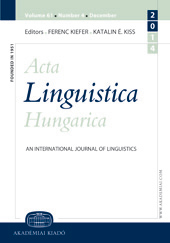Iván Fónagy (1920–2005) leitmotifs in his œuvre
Iván Fónagy (1920–2005) leitmotifs in his œuvre
Author(s): Tamás SzendeSubject(s): Phonetics / Phonology, Historical Linguistics, Theory of Communication
Published by: Akadémiai Kiadó
Keywords: phonetics; phonology; theory of communication; history of language; stylistics;
Summary/Abstract: The central motif of Iván Fónagy’s “extra-vagant” linguistics — in terms of his own metaphor — was the idea of “languages within language”: the issue of mapping the ontogenesis of language onto a particular language of the present. In other words: what is the consistent ontogenetic interpretation of a given fact of language? In his oeuvre, the inventively documented solution to that problem is the theory of “double encoding”: the claim that, after being linguistically encoded, a linguistic expression goes through a second encoding phase during implementation in which it gets saturated by supplementary aspects of content. The latter are imprints of ancient gestures in language. On the other hand, the mechanism is also the source of the historical emergence of demotivated linguistic signs. The application of the principle not only makes it possible to resolve intricate problems in theoretical linguistics but also to explain remotivation in poetic language and to use it as a tool in stylistic analysis.
Journal: Acta Linguistica Hungarica (Since 2017 Acta Linguistica Academica)
- Issue Year: 55/2008
- Issue No: 1-2
- Page Range: 131-143
- Page Count: 13
- Language: English

